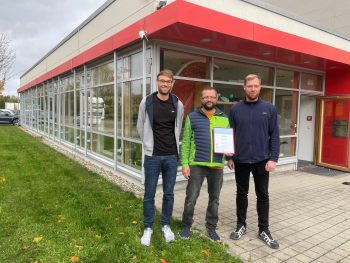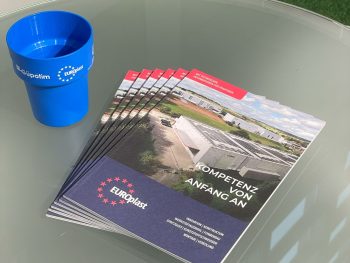EUROplast in “Plastverarbeiter” issue 06/02

Polyamide for the aviation industry — fire protection in sight
Print version in Acrobat Reader format
The problem with components with aviation approval according to ABD and FAR is, on the one hand, the low flammability required, and on the other hand, no toxic fumes must be produced in the event of a fire. A polyamide rises to the challenge.
To date, polycarbonate (PC) has often been used for aviation applications. However, this amorphous material causes problems because of its relatively poor resistance to stress cracking. There is a risk that cracks can be triggered by a superposition of stresses in conjunction with a chemical attack.
Stresses arise on plastic parts during the manufacturing process, for example during injection molding or deep drawing — with good workmanship and a plastic-friendly design of the components reducing the stress level. Depending on the application, the components can also experience considerable stress in the later installation situation due to the use of thread-forming screws instead of thread-cutting screws or incorrectly designed snap hooks.
The components required are technical functional parts of the seat mechanism. When installed, these are exposed to certain stresses and are contaminated with substances that trigger stress cracks, such as grease, but also food, hand creams or cleaning agents. After every long flight there is a cleaning, which is sometimes carried out in the most remote places in the world. This makes it difficult to specify the substances with which plastic parts may be treated. However, the use of polycarbonate, a material with high impact strength and the possibility of flame retardancy, poses the risk of stress cracking with almost every commercially available cleaning agent.
The property profile of the material that is approved for the aviation industry must meet certain requirements:
- Flammability on horizontal test (15s) according to App.F to part 25 part I § (a),(1),(v)
- Smoke density per FAR 25.853 (d)
- Smoke density according to ABD 0031
- Toxicity according to ABD 0031
- Chemical resistance
- Defined strength and elongation values
After various tests, a dry impact-resistant PA6 GF 15 FR (Foramid GM 96/30–1) was created that was suitable for the aviation industry. The polymer matrix of this material consists of polyamide 6, a semi-crystalline material with sufficient strength and elongation values as well as high chemical resistance. To achieve the flame-retardant properties, significant amounts of a phosphate- and heavy-metal-free flame retardant system were added. Furthermore, around 15% glass fiber was compounded to increase strength and rigidity. With a proportion of 30%, the material was too brittle due to the high flame retardant content. An added rubber-based impact modifier helped to increase the dry impact strength.
Processing aspects
The material can be processed like a normal PA 6 – GF15. To ensure colorability, the color must be adjusted exactly to the base material. However, it should be noted that colorability is only possible to a limited extent due to the high flame retardant content.
The plasticizing and injection conditions must be adjusted so that the blend does not separate. The parameters were determined empirically.
Despite the dry impact modification, the finished injection molded parts should still be conditioned with 2–3 % distilled water after completion. This increases the impact strength of the relatively brittle polyamide compound due to the high flame retardant content.
The injection mold is equipped with hard inserts made of hot-work steel (1.2344) and has optimal temperature control. Due to the relatively low volumes in the aviation industry, the injection is carried out using a rod and distributor without hot runner technology. Care was taken to ensure that the tunnel gate connection was sufficiently thick. This is important for low shear and sufficient pressure supply to the semi-crystalline material. The weld lines were placed in non-critical areas. Demoulding is carried out using flat and round ejectors and, in some cases, using complex slide technology.
Compound production
Due to its versatility, the polyamide polymer group has established itself as one of the most important and versatile thermoplastics in the field of injection molding granules. The macromolecule is made up of one or two different monomers. A distinction is made between PA 6 (but also PA 11 and PA 12) and PA 6.6 (but also PA 4.6 and PA 6.9). The number indicates the number of carbon atoms in the molecule.
The combination of halogen- and phosphate-free flame retardancy, glass fiber reinforcement and impact modification required for the intended purpose represents a particular challenge for the compounder. The aspects of polymer compatibility, coordination of the mechanisms of action, safety of the process, environmental compatibility and good economics must be taken into account.
Based on many years of experience, a flame retardant system based on melamine cyanurate ( melapur MC 25 from DSM ) proved to be suitable.
It is clear that in PA 6 the end groups NH2 and COOH form a bond with those of MCU, with the formation reaction taking place through opening of the rings and attachment. Cyanuric acid is broken down, which at the same time leads to the breakdown of Polymaid and thus to a lower smoke gas density. However, it has been shown that the dosage of melamine cyanurate in order to achieve the respective fire class must be set much higher than specified by the manufacturer.
While 8 weight of % was enough for the MCU 25 product from Chemie Linz in 1992 to achieve V 0 according to UL 94 (1.6 mm) for unreinforced PA 6, at least 12.5 weight of % is required with the aforementioned product .
The fire behavior of PA 6 with glass fiber was therefore only influenced by the flame retardant system to the extent that V 2 according to UL 94 (1.6 mm) was achieved. Since the components have a wall thickness of 3 mm, the flammability drops to V 1 according to UL 94 and thus meets the flame retardancy tests of the aviation industry, which differ from the tests of Underwriters Laboratories.
By adding the impact modifier, in this case an ethylene propylene rubber (EPM), to the already high flame retardant content, a complicated mixture is created that places high demands on the technological process of compounding. Without three gravimetric dosing units on the one hand and the correct choice of viscosity as a quotient of shear rate and shear stress on the other hand, consistent quality cannot be guaranteed.



Images: EP Kunststofftechnik
Authors
Dr. Gerhard Pohl, owner of Carl Pohl textile and thermoplastic production Forst / Lausitz and managing director of Dr. Pohl-Textil- und Thermoplast GmbH, Forst / Lausitz
Dipl.-Ing. Elmar Nachtsheim, Managing Director of Europlast, EP Kunststofftechnik GmbH, Ilsfeld
more comments




